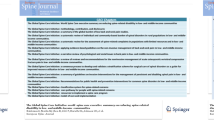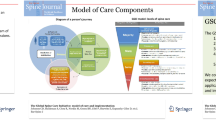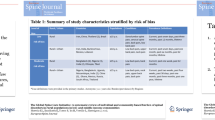Abstract
Purpose
The purpose of this study was to develop recommendations for prevention interventions for spinal disorders that could be delivered globally, but especially in underserved areas and in low- and middle-income countries.
Methods
We extracted risk factors, associations, and comorbidities of common spinal disorders (e.g., back and neck pain, spinal trauma, infection, developmental disorders) from a scoping review of meta-analyses and systematic reviews of clinical trials, cohort studies, case control studies, and cross-sectional studies. Categories were informed by the Global Spine Care Initiative (GSCI) classification system using the biopsychosocial model. Risk factors were clustered and mapped visually. Potential prevention interventions for individuals and communities were identified.
Results
Forty-one risk factors, 51 associations, and 39 comorbidities were extracted; some were associated with more than one disorder. Interventions were at primary, secondary, tertiary, and quaternary prevention levels. Public health-related actions included screening for osteopenia, avoiding exposure to certain substances associated with spinal disorders, insuring adequate dietary intake for vitamins and minerals, smoking cessation, weight management, injury prevention, adequate physical activity, and avoiding harmful clinical practices (e.g., over-medicalization).
Conclusion
Prevention principles and health promotion strategies were identified that were incorporated in the GSCI care pathway. Interventions should encourage healthy behaviors of individuals and promote public health interventions that are most likely to optimize physical and psychosocial health targeting the unique characteristics of each community. Prevention interventions that are implemented in medically underserved areas should be based upon best evidence, resource availability, and selected through group decision-making processes by individuals and the community.
Graphical abstract
These slides can be retrieved under Electronic Supplementary Material.


Similar content being viewed by others
References
Connelly LB, Woolf A, Brooks P (2006) Cost-effectiveness of interventions for musculoskeletal conditions. In: Jamison DT, Breman JG, Measham AR, Alleyne G, Claeson M, Evans DB et al (eds) Disease control priorities in developing countries, 2nd edn. World Bank, Washington, DC
March L, Smith EU, Hoy DG, Cross MJ, Sanchez-Riera L, Blyth F et al (2014) Burden of disability due to musculoskeletal (MSK) disorders. Best Pract Res Clin Rheumatol 28(3):353–366
Global Burden of Disease Study Collaborators (2015) Global, regional, and national incidence, prevalence, and years lived with disability for 301 acute and chronic diseases and injuries in 188 countries, 1990–2013: a systematic analysis for the Global Burden of Disease Study 2013. Lancet 386(9995):743–800
Hoy D, Geere JA, Davatchi F, Meggitt B, Barrero LH (2014) A time for action: opportunities for preventing the growing burden and disability from musculoskeletal conditions in low- and middle-income countries. Best Pract Res Clin Rheumatol 28(3):377–393
Jackson T, Thomas S, Stabile V, Han X, Shotwell M, McQueen K (2015) Prevalence of chronic pain in low-income and middle-income countries: a systematic review and meta-analysis. Lancet 385(Suppl 2):S10
Vancampfort D, Koyanagi A, Ward PB, Rosenbaum S, Schuch FB, Mugisha J et al (2017) Chronic physical conditions, multimorbidity and physical activity across 46 low- and middle-income countries. Int J Behav Nutr Phys Act 14(1):6
Tsang A, Von Korff M, Lee S, Alonso J, Karam E, Angermeyer MC et al (2008) Common chronic pain conditions in developed and developing countries: gender and age differences and comorbidity with depression-anxiety disorders. J Pain 9(10):883–891
Burns AS, O’Connell C (2012) The challenge of spinal cord injury care in the developing world. J Spinal Cord Med 35(1):3–8
Chamberlain JD, Meier S, Mader L, von Groote PM, Brinkhof MW (2015) Mortality and longevity after a spinal cord injury: systematic review and meta-analysis. Neuroepidemiology 44(3):182–198
Rasanathan K, Sivasankara Kurup A, Jaramillo E, Lonnroth K (2011) The social determinants of health: key to global tuberculosis control. Int J Tuberc Lung Dis 15(Suppl 2):S30–S36
Martin BI, Deyo RA, Mirza SK, Turner JA, Comstock BA, Hollingworth W et al (2008) Expenditures and health status among adults with back and neck problems. JAMA 299(6):656–664
Stewart Williams J, Ng N, Peltzer K, Yawson A, Biritwum R, Maximova T et al (2015) Risk Factors and disability associated with low back pain in older adults in low- and middle-income countries. Results from the WHO study on global AGEing and adult health (SAGE). PLoS ONE 10(6):e0127880
Louw QA, Morris LD, Grimmer-Somers K (2007) The prevalence of low back pain in Africa: a systematic review. BMC Musculoskelet Disord. 8:105
Rojas M, Gimeno D, Vargas-Prada S, Benavides FG (2015) Musculoskeletal pain in Central American workers: results of the first survey on working conditions and health in Central America. Rev Panam Salud Publica 38(2):120–128
Spiegel DA, Gosselin RA, Coughlin RR, Joshipura M, Browner BD, Dormans JP (2008) The burden of musculoskeletal injury in low and middle-income countries: challenges and opportunities. J Bone Joint Surg Am 90(4):915–923
Stewart Williams J, Kowal P, Hestekin H, O’Driscoll T, Peltzer K, Yawson A et al (2015) Prevalence, risk factors and disability associated with fall-related injury in older adults in low- and middle-incomecountries: results from the WHO Study on global AGEing and adult health (SAGE). BMC Med 13:147
Wajed J, Ahmad Y, Durrington PN, Bruce IN (2004) Prevention of cardiovascular disease in systemic lupus erythematosus–proposed guidelines for risk factor management. Rheumatology (Oxford) 43(1):7–12
Harari D, Hopper A, Dhesi J, Babic-Illman G, Lockwood L, Martin F (2007) Proactive care of older people undergoing surgery (‘POPS’): designing, embedding, evaluating and funding a comprehensive geriatric assessment service for older elective surgical patients. Age Ageing 36(2):190–196
Haldeman S, Nordin M, Chou R, Côté P, Hurwitz EL, Johnson CD, Randhawa K et al (2018) The Global Spine Care Initiative: World Spine Care executive summary on reducing spine-related disability in low- and middle-income communities. Eur Spine J. https://doi.org/10.1007/s00586-018-5722-x
Haldeman S, Johnson CD, Chou R, Nordin M, Côté P, Hurwitz EL et al (2018) The Global Spine Care Initiative: classification system for spine-related concerns. Eur Spine J. https://doi.org/10.1007/s00586-018-5724-8
Haldeman S, Johnson CD, Chou R, Nordin M, Côté P, Hurwitz EL et al (2018) The Global Spine Care Initiative: care pathway for people with spine-related concerns. Eur Spine J. https://doi.org/10.1007/s00586-018-5721-y
Johnson CD, Haldeman S, Chou R, Nordin M, Green BN, Côté P, Hurwitz EL et al (2018) The Global Spine Care Initiative: model of care and implementation. Eur Spine J. https://doi.org/10.1007/s00586-018-5720-z
Johnson CD, Haldeman S, Nordin M, Chou R, Côté P, Hurwitz EL et al (2018) The Global Spine Care Initiative: methodology, contributors, and disclosures. Eur Spine J. https://doi.org/10.1007/s00586-018-5723-9
Green BN, Johnson CD, Haldeman S, Griith E, Clay MB, Kane EJ et al (2018) A scoping review of biopsychosocial risk factors and co-morbidities for common spinal disorders. PLOS ONE 13(6):e0197987. https://doi.org/10.1371/journal.pone.0197987
Tricco AC, Lillie E, Zarin W, O’Brien K, Colquhoun H, Kastner M et al (2016) A scoping review on the conduct and reporting of scoping reviews. BMC Med Res Methodol 16:15
International Association for the Study of Pain Taxonomy Working Group (2011) Classification of Chronic Pain. 2nd (revised) ed. International Association for the Study of Pain, Washington, DC. http://www.iasp-pain.org/PublicationsNews/Content.aspx?ItemNumber=1673&navItemNumber=677. Accessed 16 Oct 2016
Deyo RA, Weinstein JN (2001) Low back pain. N Engl J Med 344(5):363–370
Elfering A, Mannion AF (2008) Epidemiology and risk factors of spinal disorders. In: Boos N, Aebi M (eds) Spinal disorders: fundamentals of diagnosis and treatment. Springer, Berlin, pp 153–173
Haldeman S, Kopansky-Giles D, Hurwitz EL, Hoy D, Mark Erwin W, Dagenais S et al (2012) Advancements in the management of spine disorders. Best Pract Res Clin Rheumatol 26(2):263–280
Mathers C, Stevens G, Mascarenhas M (2009) Global health risks: mortality and burden of disease attributable to selected major risks. World Health Organization Press, Geneva
Friis RH, Sellers TA (2009) Epidemiology for public health practice, 4th edn. Jones and Bartlett Publishers, Sudbury, p 717
Rothstein WG (2003) Public health and the risk factor: a history of an uneven medical revolution. University of Rochester Press, Rochester, p 466
Valderas JM, Starfield B, Sibbald B, Salisbury C, Roland M (2009) Defining comorbidity: implications for understanding health and health services. Ann Fam Med 7(4):357–363
Starfield B, Hyde J, Gervas J, Heath I (2008) The concept of prevention: a good idea gone astray? J Epidemiol Community Health 62(7):580–583
Hill JC, Whitehurst DG, Lewis M, Bryan S, Dunn KM, Foster NE et al (2011) Comparison of stratified primary care management for low back pain with current best practice (STarT Back): a randomised controlled trial. Lancet 378(9802):1560–1571
Norris SL, Kansagara D, Bougatsos C, Fu R (2008) Force USPST. Screening adults for type 2 diabetes: a review of the evidence for the U.S. Preventive Services Task Force. Ann Intern Med 148(11):855–868
Vernon H (2008) The Neck Disability Index: state-of-the-art, 1991-2008. J Manip Physiol Ther 31(7):491–502
MacAvoy S, Skinner T, Hines M (1996) Fall risk assessment tool. Appl Nurs Res 9(4):213–218
Preventive US (2011) Services Task Force. Screening for osteoporosis: U.S. preventive services task force recommendation statement. Ann Intern Med 154(5):356–364
Harden CL, Meador KJ, Pennell PB, Hauser WA, Gronseth GS, French JA et al (2009) Management issues for women with epilepsy-Focus on pregnancy (an evidence-based review): II. Teratogenesis and perinatal outcomes: Report of the Quality Standards Subcommittee and Therapeutics and Technology Subcommittee of the American Academy of Neurology and the American Epilepsy Society. Epilepsia 50(5):1237–1246
World Health Organization (2006) Guidelines for drinking-water quality. World Health Organization, Geneva. http://www.who.int/water_sanitation_health/dwq/gdwq0506.pdf. Accessed 2 Mar 2017
Scherer M, Hansen H, Gensichen J, Mergenthal K, Riedel-Heller S, Weyerer S et al (2016) Association between multimorbidity patterns and chronic pain in elderly primary care patients: a cross-sectional observational study. BMC Fam Pract 17:68
Jeremiah MP, Unwin BK, Greenawald MH, Casiano VE (2015) Diagnosis and management of osteoporosis. Am Fam Phys 92(4):261–268
McKenzie JF, Pinger RR, Kotecki KE (2008) Community organization/building and health promotion programming. In: McKenzie JF (ed) An introduction to community health. Jones and Bartlett Publishers, Sudbury, pp 120–144
Cosman F, de Beur SJ, LeBoff MS, Lewiecki EM, Tanner B, Randall S et al (2014) Clinician’s guide to prevention and treatment of osteoporosis. Osteoporos Int. 25(10):2359–2381
Bolland MJ, Leung W, Tai V, Bastin S, Gamble GD, Grey A et al (2015) Calcium intake and risk of fracture: systematic review. BMJ 351:h4580
Reid IR, Bolland MJ, Grey A (2014) Effects of vitamin D supplements on bone mineral density: a systematic review and meta-analysis. Lancet 383(9912):146–155
Winzenberg TM, Shaw K, Fryer J, Jones G (2006) Calcium supplementation for improving bone mineral density in children. Cochrane Database Syst Rev 2:CD005119
Nguyen VH (2017) Community osteoporosis screening services for the prevention of osteoporotic fractures in population health: a literature review. Int J Evid Based Healthc 15(2):43–52
Dinh-Zarr TB, Sleet DA, Shults RA, Zaza S, Elder RW, Nichols JL et al (2001) Reviews of evidence regarding interventions to increase the use of safety belts. Am J Prev Med 21(4 Suppl):48–65
Lee BB, Cripps RA, Fitzharris M, Wing PC (2014) The global map for traumatic spinal cord injury epidemiology: update 2011, global incidence rate. Spinal Cord 52(2):110–116
Jazayeri SB, Beygi S, Shokraneh F, Hagen EM, Rahimi-Movaghar V (2015) Incidence of traumatic spinal cord injury worldwide: a systematic review. Eur Spine J 24(5):905–918
van den Berg ME, Castellote JM, de Pedro-Cuesta J, Mahillo-Fernandez I (2010) Survival after spinal cord injury: a systematic review. J Neurotrauma 27(8):1517–1528
Kraft R, Dorstyn D (2015) Psychosocial correlates of depression following spinal injury: a systematic review. J Spinal Cord Med 38(5):571–583
Craig A, Tran Y, Middleton J (2009) Psychological morbidity and spinal cord injury: a systematic review. Spinal Cord 47(2):108–114
Dijkers M, Bryce T, Zanca J (2009) Prevalence of chronic pain after traumatic spinal cord injury: a systematic review. J Rehabil Res Dev 46(1):13–29
Gilbert O, Croffoot JR, Taylor AJ, Nash M, Schomer K, Groah S (2014) Serum lipid concentrations among persons with spinal cord injury—a systematic review and meta-analysis of the literature. Atherosclerosis 232(2):305–312
Xing D, Wang J, Song D, Xu W, Chen Y, Yang Y et al (2013) Predictors for mortality in elderly patients with cervical spine injury: a systematic methodological review. Spine (Phila Pa 1976) 38(9):770–777
van Middendorp JJ, Albert TJ, Veth RP, Hosman AJ (2010) Methodological systematic review: mortality in elderly patients with cervical spine injury: a critical appraisal of the reporting of baseline characteristics, follow-up, cause of death, and analysis of risk factors. Spine (Phila Pa 1976) 35(10):1079–1087
World Health Organization (2007) Preventing Injuries and violence: a guide for ministries of health. World Health Organization, Geneva
World Health Organization (2013) Global status report on road safety 2013. World Health Organization, Geneva
Krug EG, Sminkey LA (2007) The role of the ministry of health in preventing injuries and violence. Int J Inj Contr Saf Promot 14(3):199–201
Cooper BS, Medley GF, Stone SP, Kibbler CC, Cookson BD, Roberts JA et al (2004) Methicillin-resistant Staphylococcus aureus in hospitals and the community: stealth dynamics and control catastrophes. Proc Natl Acad Sci USA 101(27):10223–10228
Lonnroth K, Castro KG, Chakaya JM, Chauhan LS, Floyd K, Glaziou P et al (2010) Tuberculosis control and elimination 2010-50: cure, care, and social development. Lancet 375(9728):1814–1829
Kamara E, Mehta S, Brust JC, Jain AK (2012) Effect of delayed diagnosis on severity of Pott’s disease. Int Orthop 36(2):245–254
Rajasekaran S (2007) Buckling collapse of the spine in childhood spinal tuberculosis. Clin Orthop Relat Res 460:86–92
Rajasekaran S, Prasad Shetty A, Dheenadhayalan J, Shashidhar Reddy J, Naresh-Babu J, Kishen T (2006) Morphological changes during growth in healed childhood spinal tuberculosis: a 15-year prospective study of 61 children treated with ambulatory chemotherapy. J Pediatr Orthop 26(6):716–724
Lonnroth K, Migliori GB, Abubakar I, D’Ambrosio L, de Vries G, Diel R et al (2015) Towards tuberculosis elimination: an action framework for low-incidence countries. Eur Respir J 45(4):928–952
Rodrigues-De-Souza DP, Fernandez-De-Las-Penas C, Martin-Vallejo FJ, Blanco-Blanco JF, Moro-Gutierrez L, Alburquerque-Sendin F (2016) Differences in pain perception, health-related quality of life, disability, mood, and sleep between Brazilian and Spanish people with chronic non-specific low back pain. Braz J Phys Ther 20(5):412–421
Susser M, Susser E (1996) Choosing a future for epidemiology: I. Eras and paradigms. Am J Public Health 86(5):668–673
Krieger N, Zierler S (1996) What explains the public’s health?—A call for epidemiologic theory. Epidemiology 7(1):107–109
Susser M, Susser E (1996) Choosing a future for epidemiology: II. From black box to Chinese boxes and eco-epidemiology. Am J Public Health 86(5):674–677
Broadbent A (2009) Causation and models of disease in epidemiology. Stud Hist Philos Biol Biomed Sci 40(4):302–311
Funding
The Global Spine Care Initiative and this study were funded by Grants from the Skoll Foundation and NCMIC Foundation. World Spine Care provided financial management for this project. The funders had no role in study design, analysis, or preparation of this paper.
Author information
Authors and Affiliations
Corresponding author
Ethics declarations
Conflict of interest
BNG receives speaker fees and travel reimbursement from NCMIC Speakers' Bureau; he is secretary of Brighthall Inc; the views in this article are those of the authors and not those of Stanford University, Stanford Health Care, or Qualcomm. CDJ is president of Brighthall Inc; she is an NCMIC Board of Director, however neither she nor NCMIC board make funding decisions for the NCMIC Foundation; the views in this article are those of the authors and not those of Stanford University, Stanford Health Care, or Qualcomm. SH declares funding to UOIT from Skoll Foundation, NCMIC Foundation through World Spine Care. Clinical Policy Advisory Board and stock holder, Palladian Health. Advisory Board, SpineHealth.com. Book Royalties, McGraw Hill. Travel expense reimbursement—CMCC Board. EJK declares no COI. MBC declares no COI. EAG declares no COI. JMC declares funding from Spanish Government Grant ESPY 112/18. MS declares no COI. SR declares no COI. EH declares he is a consultant for: RAND Corporation; EBSCO Information Services; Southern California University of Health Sciences; Western University of Health Sciences Data and Safety Monitoring Committee. Chair, Palmer Center for Chiropractic Research. Research Committee Co-chair, World Spine Care. MN declares funding from Skoll Foundation and NCMIC Foundation through World Spine Care; Co-Chair, World Spine Care Research Committee. Palladian Health, Clinical Policy Advisory Board member. Book Royalties Wolters Kluwer and Springer. Honoraria for speaking at research method courses. PC is funded by a Canada Research Chair in Disability Prevention and Rehabilitation at the University of Ontario Institute of Technology and declares funding to UOIT from Skoll Foundation, NCMIC Foundation through World Spine Care. Canadian Institutes of Health Research Canada. Research Chair Ontario Ministry of Finance. Financial Services Commission of Ontario. Ontario Trillium Foundation, ELIB Mitac. Fond de Recherche and Sante du Quebec. KR declares funding to UOIT from Skoll Foundation, NCMIC Foundation through World Spine Care. HY declares funding to UOIT from Skoll Foundation, NCMIC Foundation through World Spine Care.
Electronic supplementary material
Below is the link to the electronic supplementary material.
Rights and permissions
About this article
Cite this article
Green, B.N., Johnson, C.D., Haldeman, S. et al. The Global Spine Care Initiative: public health and prevention interventions for common spine disorders in low- and middle-income communities. Eur Spine J 27 (Suppl 6), 838–850 (2018). https://doi.org/10.1007/s00586-018-5635-8
Received:
Accepted:
Published:
Issue Date:
DOI: https://doi.org/10.1007/s00586-018-5635-8




